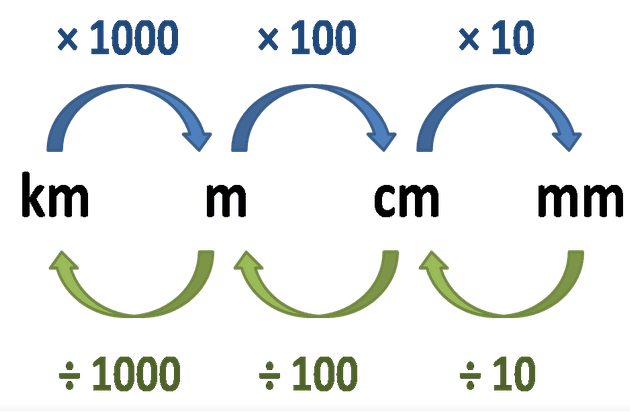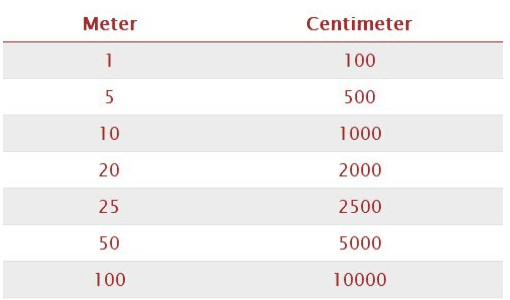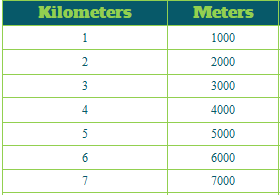JUMP TO TOPIC
Metre (Meter)|Definition & Meaning
Definition
Meter (metre in the UK) is the standard unit of length in SI units (also called the Metric system). It is abbreviated with the letter m and officially defined as the distances covered by the light within a vacuum in exactly 1/299,792,458 parts of a second.
What Is a Meter?
The English word “meter” was derived from the Greek word “measure,” which was the source of the term. In the International System of Units, sometimes known as SI units, the meter is the fundamental unit for determining length. It is denoted by the letter “m” in the symbol set. In some nations, meters are also referred to as meters, which is yet another unit of length measurement.

Figure 1: Representation of meter conversions.
In the international system of units (SI), the fundamental unit of length is the meter. The length of time that exactly 1/299792458 of a second passes for light to move in a vacuum is the basis for the definition of the meter. One of the intriguing side effects of defining the meter in this manner is that it locks the velocity of light within a vacuum to the precise figure of 299,792,458 meters per second.
The meter used to be defined as one ten-millionth of the distance from the geographical north pole to the equator, and it was measured over the surface of the world in a circle that went through Paris, France. However, this definition has since been revised. When measuring, the word “meter” is abbreviated with a lowercase “m.”
About 39.37 inches is equal to 1 meter. A yard and a half are slightly longer than this. A mile, according to legislation, is equal to 1609 meters. Prefix multipliers depending on powers of 10 are utilized to convert meters to other SI units.
For illustration purposes, one meter is equal to one hundred centimeters. One meter is equivalent to one thousand millimeters. A kilometer is comprised of one thousand meters.
SI Unit
SI is a worldwide standard that expresses the magnitudes or quantities of significant natural events. The System of Units is frequently shortened as SI, which derives from the French term for the system, which is Système international d’unités. The metric system is another name for the System of Units. The meter-kilogram-second (MKS) system, developed much earlier than the SI standard, serves as the basis for the SI standard.
The International System of Units (SI) is promoted and defined by the Bureau of international des poids et measures (BIPM), an international organization that has been around since 1875. The International Commission governs it for Weights and Measures (CIPM) was founded in 1875. (CIPM). The Conférence générale des poids et mesures (CGPM), often known as the General Conference on Weights and Measures, is the governing body that oversees the activities of the Commission internationale pour les mesures (CIPM). Es.
The International System of Units (SI) standard is built on a foundation of seven defining constraints, which serve as the basis for all measurement units specified in the SI standard.
Electrical or Magnetic Quantity
An instrument that measures and keeps track of the quantity of a material is referred to as a meter. A water meter, for instance, is a device that calculates the water’s volume. Your smartphone keeps track of the amount of digital information you use.
A meter is any device that measures an electrical or magnetic measure, such as voltage or current, and may also record the measurement results. For instance, an ammeter or voltmeter are sorts of meters. It’s possible to refer to the utilization of a device like this as “metering,” or you could state that the quantity being measured is being “metered.”
Conversions
In addition to understanding what a meter is and how to use it, it is essential to convert between different length units when working with length measurements. The following is a breakdown of the various meter conversions.
Meter to Centimeter
The symbol for the centimeter, which is also the unit of measurement for distance, is “cm.” One meter is equal to one hundred centimeters when converting between the two units of measurement.

Figure 2: Conversion of meter to a centimeter.
Meter to Millimeter
“mm” is a common abbreviation for the millimeter, which is the unit of measurement. A meter is equal to one thousand millimeters, so one meter is equal to one thousand millimeters.
Yards to Meters
If you measure things in yards, knowing how to convert them to meters is a useful skill to have. Since a yard and a meter are very near in size to one another, you should double-verify the values to ensure they are reasonably close when you have an answer. The figure expressed in meters needs to be lower than the value expressed in yards.
1 yards = 0.9144 meters
If you need to convert 100 yards to meters, the formula is as follows:
100 yards × 0.9144 meters for every yard = 91.44 meters
Centimeters to Meters
The majority of the time, metric units are used as the starting point when converting length units. The following is the formula to convert centimeters to meters:
1 m Equals 100 cm (or 100 cm = 1 m)
Let’s say you need to get from millimeters to meters, and you have 55.2 of them:
55.2 cm x (1 meter / 100 cm) = 0.552 m
Check that the units cancel entirely each other out, leaving only the one you need “on top.” In this illustration, the centimeters are nullified, and the meters count is presented in ascending order.
Kilometers to Meters
The conversion from kilometers to meters is quite common.
1 km = 1000 m
Let’s say you need to translate 3.22 kilometers into meters. When canceling units, remember to check to see that the desired unit is still in the numerator. In this particular instance, there is no mystery involved:
3.22 kilometers x 1000 m/km = 3220 meters
A second aspect to keep a check on is the number of significant numbers contained in a response. There are three essential digits in this particular illustration.

Figure 3: Conversion from kilometer to meter.
Examples Using Meters
Example 1
Harry took an 1800 km trip, traveling by bus and plane. The bus averaged 70 km/h, and the plane averaged 600 km/h. How many meters did he travel by bus if the trip took 4 hours?
Solution
Total kilometers travel = 1800 km
Bus average = 70 km/h
Plane average = 600 km/h
Let a and b be the distance traveled by bus and plane, respectively.
a + b = 1800 …Eq (1)
b = 1800 – a
Putting the value of b in eq (1):
a/70 + (1800-a)/600 = 4
Now taking LCM:
[600a + 70(1800 – a)]/42000 = 4
(600a + 126000 – 70a)/ 42000 = 4
530a + 126000 = 4 * 42000
530a + 126000 = 168000
530a = 168000 – 126000
530a = 42000
a = 42000/530
= 79.2 km
= 79.2 * 1000
= 79200 m
Example 2
Jimmy took 6 hours to complete his journey. For the first 3 hours, he traveled at a speed of 70 km/h, and the rest of the time, he traveled at a speed of 75 km/h. What is the total distance he traveled in meters?
Solution
The distance traveled in the first half = 70 * 3 = 210 km
The time for the rest of the journey = 6 – 3 = 3 hours
The distance for the rest of the journey = 75 * 3 = 225 km
The total distance = 210 km + 225 km
= 435 km
= 435 * 1000 = 435000 meters
All images/graphs are created using GeoGebra.
